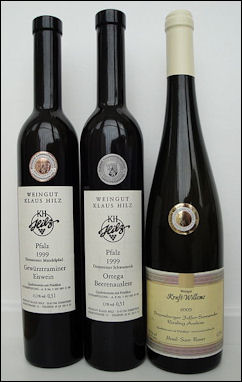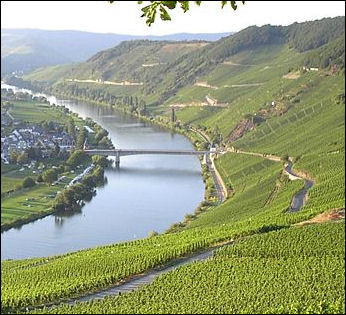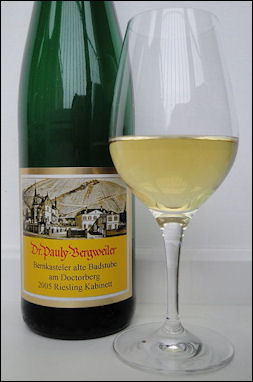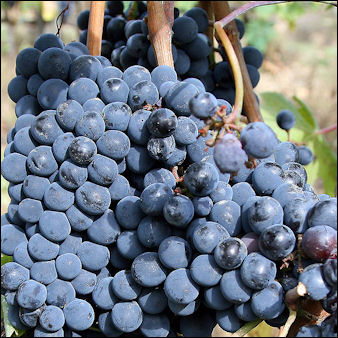GERMAN WINE

German wines with KPM medals German wines are regarded as being "cheap and sweet" and having less body than French wines. This is not necessarily true with top-end German wines. Better German wines are "dry" and "robust" white wines that go well with fish and game. They include top-quality Reislings and Spaetburgens. Among the most famous wines are Schloss Vollrads and Höllenberg.
Germany is the northernmost of all major wine-growing areas. The cool climate results in a slow maturation process and produces sweet and fruity white wines. Because the weather is not so sunny, German farmers postpone harvesting until as late as possible to increase the sweetness of their grapes. This generally produces thick and sweet yet smooth wines.
The Mosel, Ahr and Rhine valley are Germany's most famous wine-growing areas. They produce two thirds of Germany's wine. The Rhineland and Moselle areas have a cool climate that favors white wines with a strong, fruity apple taste. The Rhine and Mosel valleys are known for the sweet (“lieb”) wines and southwest Baden is known for its dry (“troken”) wines. White German wines are generally made from white Riesling grapes.
German red wine are often considered to be thin sweet, watery and boring and are more pink than red. In the mid 1990s wine reviewers began raving about a "German red wine miracle" after some top quality dark red wines made with a kind of grape unique to Germany, called dornfelder, were discovered.
Book: The Simon & Schuster Guide to the Wines of Germany by Ina Jamieson.
Websites and Resources: Guardian & Observer Guide to Wine guardian.co.uk/lifeandstyle/page ; Wine Anorak wineanorak.com ; Wine Spectator winespectator.com ; Wine.com wine.com ; Wikipedia article Wikipedia ; Tesco Wine tesco.com/wine ; Wine Types wineintro.com/types/ ; Types of Wineslovetoknow.com/wiki/Category:Types_of_Wine ; Types of Wine Grapes frenchscout.com/types-of-wines ; History of Wine winepros.org/wine101/history ; Wikipedia article on History of Wine Wikipedia ; History of Wine Cornell University /rmc.library.cornell.edu/ewga/exhibition ; Winemaking wineintro.com/making ; Wine Producing madehow.com

Mosel area
German Wine Production
Germany is the biggest wine importer in the world, the third largest producer and seventh largest exporter. The world's top wine producers in 1995 were: Italy (64 million hectoliters), France (50 million), Germany (45 million) and Spain (40 million).
The Breisach wine cooperative corks half a million bottles of wine a year and supplies 22,800 vintners. Tanks several stories high.
A rebellion against low-quality sweet German wines in the late 1980s and early 1990s caused a severe declines in German wine exports and the slack was partly taken up by "new world" wines from Chile, Argentina and Hungary.
In an efforts to change the reputation of German wines for the better, many vintners began producing dryer, higher grade vintages at lower yields. Wine production dropped from 14 million hectoliters in the early 1980s to 8.5 million hectoliters partly as a result government intervention to keep wine output from rising and prices from spiraling downward.
Liebfraumilch and Blue Nun

Pauly-Bergweiler
Riesling Kabinett 2005 Liebfraumilch, one of Germany's best known wines, is regarded as "cheapest and sweetest" of all cheap and sweet German wines. A medieval term that literally means the milk from convents and monasteries in the Rhine Valley, Liebfraumilch is a blend of wines described by one critic as a "basic, easy-swilling beginner's wine.”
Blue Nun itself as the "world's oldest wine brand." One of Germany's most well known brand names and one of the best selling wines ever, it is sweet and inexpensive and sold in brown bottles, and made from low-quality grapes bought up from the Rhineland by Germany's leading wine producer.
In 1982, Blue Nun sold about 20 million bottles of wine for about $5 a bottle. This helped propel Germany to the position as the world's fifth-largest wine exporter. In 1998, only about 7 million bottles of Blue Nun were sold in 80 countries. Too boost sales, labels were redesigned and the wine was called fruity (rather than sweet).
Ice Wines
Some vintners in the Rhine valley of German and the Alsace of Germany and France produce ice wine, one of the rarest and most expensive wines in the world. Grapes are mostly water. In ice wines, the water is separated from the sweet juice which has a low freezing. The sweet, concentrated juice is used to make the wine. With its concentrated sweetness and high acidity, ice wines are good at a young age. [Source: Frank Prial, New York Times]
Ice wines first appeared in the 1960s. Bottles usually sell for a $100 or more. Making ice wine is an extremely risky proposition. Growers keep the grapes in the vine well into December and even January when the grapes are vulnerable to rain, rot and birds. The temperature at the vineyard has to be 18̊F or lower for the water and the juice to separate properly. The grapes are usually harvested early in the morning by pickers who aren't allowed to wear gloves.
Italian Wine

Sangiovese grapes used in chianti Italy has never been known for its premium wine vintages. Nonetheless it produces a lot of wine and Italians drink it like water. The average Italian adult consumes 107 bottles of wine a each year. One Italian man said, "My father only drank one glass of wine at meals — a one liter glass.” Italian doctors have suggested that drinking 1½ liters of wine per day could prevent Alzheimer's and Parkinson's disease.
In Italy, friends like to relax over a bottle of wine. Red wine is more commonly drunk than white wine. Italian reds tend to be deep purple in color. Italy is home to over a thousands varieties grapes, of which bout a400 are in regularly in use. Many of the grapes have origins in ancient Greece, Rome and Etrucsa.
Top wine consumers (liters per capita): 1) France (60), 2) Italy (59.4), 3) Portugal (more than 50), 4) Luxembourg (more than 50). In contrast Americans only consume 7.7 liters and Japanese only 1.3 liters. 1996
The world's top wine producers in 1995 were: Italy (64 million hectoliters), France (50 million), Germany (45 million) and Spain (40 million).
Top Italian wine-producing regions: 1) Sicily, 2) Veneto, 3) Aoulia, and 4) Emilia-Romagna. Barolo is well-known Italian wine. It is freshly fruit wine, White Barolo bianco us especially prized. Greco de Tufo is one of southern Italy's most famous wines. Asti Spumante is asparkling champagne-like wine.
Chianti

Fiasco di chianti monteriggioni Chianti describes a wine and a wine growing region in Tuscany. The region is covered mostly by rolling hills and broad valleys. The best chianti — Gallo Nero (black rooster) — comes from the mountains between Siena and Florence and is centered around the town of Greve.
Most Chianti is a young wine made from a ratio of two red grapes to one white one. Sangiovese is the principal grape used in the making if Chianti. It appears to have been derived from grape varieties cultivated in Tuscany by the Etruscans.
The most famous Chianti wine is grown around massive Brolio castle, located an elevation of 2000 feet, and surrounded by olive trees and terraced vineyards, some off them having been tended for 1,000 years. South of Siena in the fortified town of Montalcino wine growers produce Brunello, one of Italy's premier red wines, whose vintages from the 19th century have sold for thousands of dollars.
The Chianti name is weakly protected and not widely enforced. Bad chiantis made in the 1960s gave the wine a bad name, but varieties have been improved with grapes brought from France.
Image Sources: Wikimedia Commons
Text Sources: National Geographic, New York Times, Washington Post, Los Angeles Times, Smithsonian magazine, Natural History magazine, Discover magazine, Times of London, The New Yorker, Time, Newsweek, Reuters, AP, AFP, Lonely Planet Guides, Compton’s Encyclopedia and various books and other publications.
Last updated March 2011
